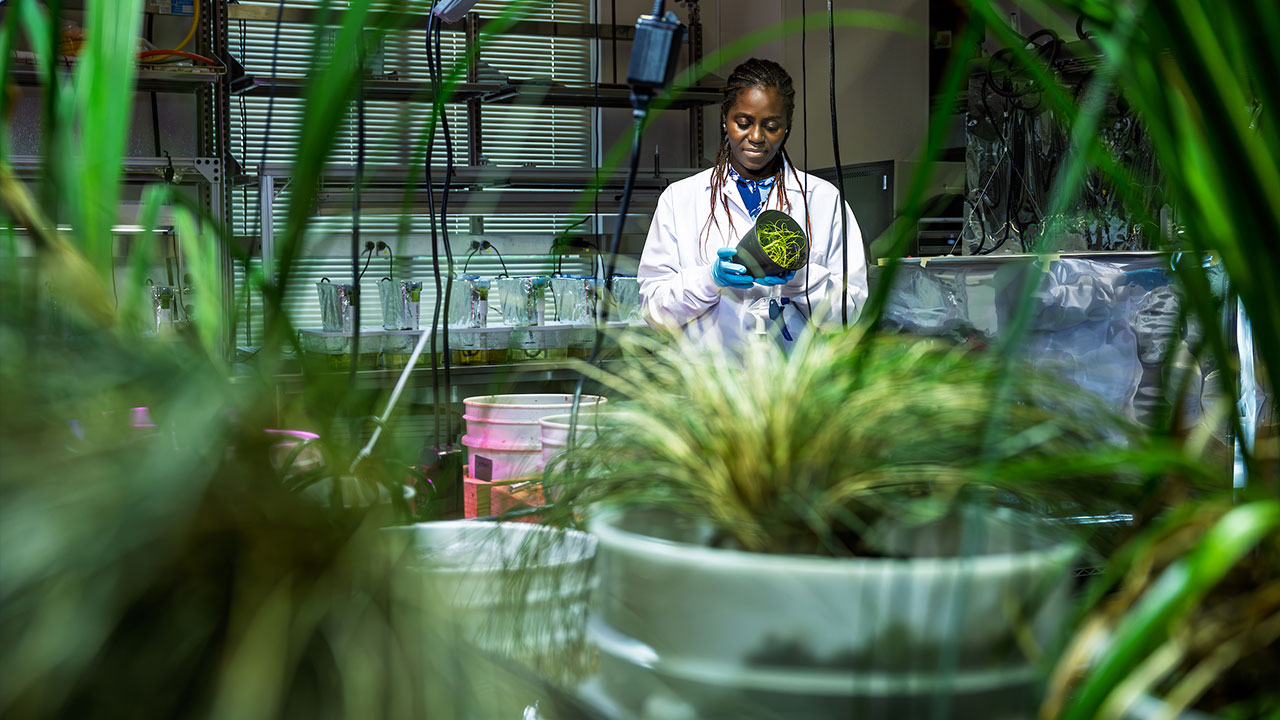content body
Contrary to what the name might suggest, the work currently happening in the Green Infrastructure Lab at Auburn has nothing to do with green-colored roads or buildings. No Emerald City here.
“Green infrastructure is an approach to managing water and environmental sustainability that uses natural processes to provide benefits like reducing pollution, improving water quality and enhancing biodiversity and biological processes in built environments,” said David Blersch, an associate professor of ecological engineering in the College of Agriculture’s Department of Biosystems Engineering.
It's ‘green’ because “it incorporates a network of natural systems and processes — green space, wetlands, green roofs, trees, rain gardens and permeable surfaces — that mimic natural ecosystems to manage water, reduce urban heat and create healthier urban environments,” he added.
Since clean water is essential for life on Earth, and maintaining it requires reducing pollution and promoting biodiversity, Blersch’s work is crucial for ensuring a healthy environment.
The problem
Pollutants like nitrogen and phosphorus in wastewater can harm ecosystems if left untreated.
Wastewater treatment facilities clean water from household toilets, sinks, showers and washing machines; manufacturing and processing plants; and agricultural runoff to make it safe to return to the environment.
According to the Environmental Protection Agency, approximately 34 billion gallons of wastewater — enough to fill the Martin Aquatics Center pool 50,000 times — are processed at treatment plants daily.
The process can be costly and, when it comes to removing certain pollutants, can also be energy-intensive. Blersch and his team are working on an alternative method. They use algae, not just any variety of the green slimy substance from lakes and ponds, but filamentous algae, which absorb pollutants quickly.
For this research, the team recreates nature in the lab. Overhead lighting mimics the sun, stimulating algae growth on different fabric materials that resemble the surface of rocks and aquatic plants. These materials line a series of gutters connected to a continuous stream of wastewater, like a river.
They have found that farming the algae — delicately removing it from the materials — withdraws pollutants, creating clean water and algae for repurposing.
“These algae may be used as a feedstock for other reuse products, such as soil fertilizer or a source for bioplastics,” Blersch said. “The overall project is a resource recovery strategy that maximizes sustainability using photosynthesis — the original solar-powered approach.
“So far, we’ve learned that the algae we grow prefer some surfaces better than others, and we can use that information to design a better growing system.”
Another solution
The team also seeks to address a pollutant problem in the poultry processing industry, a major U.S. agricultural sector, supported by 18 commercial plants in Alabama alone.
Knowing that wastewater treatment at these processing plants is costly and involves multiple stages, a natural treatment system could lower energy costs, reduce environmental impact and support long-term productive land use.
The research, supported by the USDA Agricultural Research Service, involves using tidal flow wetlands — known to filter and transform pollutants — as a natural system for wastewater treatment.
Blersch’s team has recreated wetlands in the lab with buckets containing various plants and soil amendments, such as peat moss and limestone, flowing wastewater and artificial sun.
These wetland ecosystems, specifically the soil, plants and microbes they contain, break down and neutralize pollutants — forms of carbon, nitrogen and phosphorus — in wastewater and leave behind harmless, natural products that are safe for the environment.
Blersch said they aim to create large-scale systems that will provide a green habitat for wastewater treatment in rural areas where much of the poultry industry is found.
“In both projects, we hope to learn the optimum set of conditions for growing the green components — algae or plants — that will maximize the performance of the wastewater treatment processes,” he said.
Later this year, the team will use large-scale versions of these systems to test wastewater from fish aquaculture at the E.W. Shell Fisheries Center on North College Street.

David Blersch, third from the right, is conducting two research projects involving wastewater treatment in the Green Infrastructure Lab, with the help of a team of doctoral students.
The future is green
When Blersch isn’t utilizing the Green Infrastructure Lab in the Center for Advanced Science, Innovation and Commerce, he leads his own lab, the Algae Systems and Ecological Engineering Lab.
Between them, Blersch will advocate for green infrastructure and ecological engineering to support long-term environmental resilience. Like his current research, he envisions sustainable systems becoming the norm, offering cost-effective, adaptable and environmentally friendly alternatives to conventional treatment.
Auburn’s approach reduces costs and recycles pollutants into valuable resources, protecting water quality in the process.
“This is all driven by the sun’s natural energy, effectively defining what it means to be sustainable,” he said. “The future will require green technologies for water and wastewater management, and those innovations are happening right here at Auburn.”










